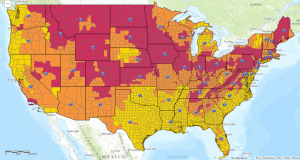
Map of radon levels in the United States; image courtesy of the EPA
January is National Radon Action Month, and Iowans need to take notice, according to the Environmental Protection Agency. Radon is an invisible, tasteless, odorless, radioactive gas that is the leading cause of lung cancer in non-smokers in America. Radon levels are measured in picoCuries per liter of air (pCi/L), and Iowa has the highest overall levels in the country. Jennine Wolf, Director of Washington County Environmental Health, says the excess radon in Iowa isn’t caused by anything other than an overabundance of uranium breakdown in the earth’s crust. She explains, “All of Iowa is in the radon hot pocket. Right now, for all the radon test kits that we’ve given out and gotten results back, over half of Washington County has radon over 4.1 (pCi/L), which is the EPA’s recommended allowance.”
While Iowans did nothing to cause the high levels of radon, Wolf says there are things people can do to reduce the radon levels in their homes. She says the first step is to test for radon, which can be done using a test kit supplied by Environmental Health. If the radon levels come back at more than 4.1, mitigation systems can be installed that will vent the radon out of houses. Wolf says those systems can cost between $800-$2,000, and many homes in Iowa are currently being built with them already installed. For more information about radon and National Radon Action Month, listen to the In Touch with Southeast Iowa interview with Wolf at KCIIRadio.com.

